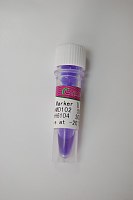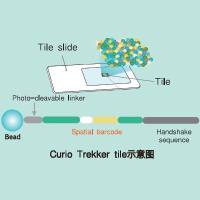Mapping DNA Interaction Sites of Chromosomal Proteins: Crosslinking Studies in Yeast
互联网
630
Eucaryotes use a common theme for packaging genomic DNA: 146 bp of DNA are wrapped around an octameric protein core consisting of two molecules each of the histones H2A, H2B, H3, and H4. Although this nucleosomal arrangement is ubiquitous throughout the genome, different chromosomal portions are nonetheless functionally and structurally distinct. This is owing to regional interactions between regulatory chromosomal proteins (i.e., transcription factors, structural components, histone-modifying enzymes) and specific portions of the chromosome. Therefore it is important to determine the natural sites of action of these chromatin (re-)modeling factors and to gain insight into the parameters governing their association with chromatin in vivo. To address this problem, Orlando and Paro (
1
) have used formaldehyde crosslinking to prevent redistribution of chromatin components during chromatin preparation, immunoprecipitation to isolate the chromosomal factor(s) to be investigated and hybridization to enable the detection of genomic sequences contacted by the factor(s) (
see
Chapter 33 ). A similar approach has been used by Braunstein et al. (
2
), employing antibodies against sites of histone acetylation, to determine the acetylation state of histones in chromatin sites. We have streamlined and further developed this protocol and included a polymerase chain reaction (PCR) step to more sensitively and rapidly map the chromosomal distribution of regulatory proteins in
Saccharomyces cerevisiae
(Fig. 1 ).
Fig. 1.
Strategy for the mapping of chromosomal interaction sites of nonhistone chromatin associated factors. Yeast cells are crosslinked with formaldehyde in vivo
(A)
and subsequently disrupted mechanically. Chromatin fragments released from the cells are sheared by sonication
(B)
to an average size suitable for the desired accuracy and resolution of the mapping experiment. Antibodies recognizing a chromosomal non-histone protein are added and protein-DNA complexes are recovered by adsorption to proteinA sepharose beads
(C)
. Samples from the INPUT and PRECIPITATE are heat-treated to reverse the crosslinks and DNA is isolated
(D)
. The purified DNA is then used as template in multiplex PCR reactions with primer pairs derived from different chromosomal regions. Control PCR reactions with decreasing amounts of template are analyzed in parallel to assure that the PCR was still in the exponential phase to allow for a quantitative interpretation of the results
(E)
.
(F)
Polyacrylamide gel electrophores’s is used to separate and visualize different sized PCR products. Bound as well as unbound sequences are equally represented in the genome and will be amplified accordingly from the INPUT sample. Only sequences specifically bound by the regulatory protein in vivo coimmunoprecipitate with this factor (the shaded area in the P1/P2 region symbolizes an interaction site) and will give rise to PCR products from the PRECIPITATE
(F)
.





